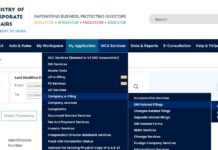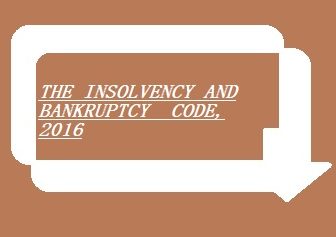Insolvency Resolution and Liquidation for Corporate Persons means the Corporate Insolvency Resolution Process (‘CIRP’) is a recovery mechanism for the creditors of a corporate debtor. A corporate debtor means a company or Limited Liability Partnership (‘LLP’) that owes a debt to its creditors.
Q18. When is the applicability of the provisions of insolvency resolution and liquidation on a corporate person?
(a) When the amount of the default is one lakh rupees or more
(b) When the amount of the default is ten lakh rupees or more
(c) When the amount of the default is two lakh rupees or more
(d) Amount of default is immaterial
Q19. Who among the following is considered as constitutional document in relation to corporate person under IBC, 2016?
(a) Articles of association
(b) Memorandum of association of a company
(c) Incorporation document of a limited liability partnership
(d) All of the above
Q20. Insolvency resolution process costs under the Code does not include:
(a) The amount of any interim finance and the costs incurred in raising such finance
(b) The fees payable to any person acting as a resolution professional
(c) Any payment of fees for the services of an insolvency professional to any person other than the insolvency professional
(d) any costs incurred at the expense of the Government to facilitate the insolvency resolution process
Q21. Dispute does not includes a suit or arbitration proceedings relating to:
(a) the quality of goods or services
(b) rights and liabilities of a person
(c) existence of the amount of debt
(d) breach of a representation or warranty
Q22. Resolution Professional under the Code means:
(a) Insolvency Professional appointed to conduct CIRP
(b) Interim resolution professional
(c) Both (a) and (b)
(d) None of the above
Q23. Persons who can initiate Corporate Insolvency Resolution process are:
(a) Financial Creditor and Operational creditor
(b) Financial Creditor, Operational Creditor and Corporate debtor
(c) Financial Creditor and Corporate Debtor
(d) Operational Creditor and Corporate Debtor
Q24. Who among the following is the Adjudicating Authority under the Code:
(a) Registrar of Companies
(b) Regional Director of Companies
(c) National Company Law Tribunal
(d) Debt Recovery Tribunal
Q25. Date of commencement of The Corporate Insolvency Resolution Process shall be;
(a) Date of filing application before Adjudicating Authority
(b) Due date for payment which has not been met by the debt
(c) Date of admission of the application by the Adjudicating authority
(d) Date of communication of order by Adjudicating authority
Q26. Once the application is received, the adjudicating authority shall confirm the existence
of default within:
(a) 7 days
(b) 14 days
(c) 21 days
(d) None of the above
Q27. The Adjudicating Authority before rejecting the application for initiating Corporate Insolvency Resolution Process shall give a notice to the applicant to rectify the defects in the application within ——- days of receipt of such notice.
(a) 10
(b) 14
(c) 7
(d) 30
Q28. When can an Operational creditor file application before the adjudicating authority?
(a) After expiry of the period of Ten days from the date of delivery of notice under sub section 1 of section 8
(b) After expiry of the period of Fifteen days from the date of delivery of notice under sub section 1 of section 8
(c) After expiry of the period of Eight days from the date of delivery of notice under sub section 1 of section 8
(d) After expiry of the period of Twenty eight days from the date of delivery of notice under sub section 1 of section 8
Q29. Documents furnished along with application by operational creditors include:
(a) Copy of Invoice
(b) Copy of certificate from the financial institution
(c) Both (a) and (b)
(d) None of the above
Q30. Corporate Insolvency Resolution process shall be completed within a period of:
(a) 120 days from the date of admission of application
(b) 180 days from the date of admission of application
(c) 140 days from the date of admission of application
(d) 100 days from the date of admission of application
Q31. Persons not entitled to make application:
(a) A corporate debtor having completed corporate insolvency resolution process twenty four months preceding the date of making of the application
(b) A corporate debtor having completed corporate insolvency resolution process fifteen months preceding the date of making of the application
(c) A corporate debtor having completed corporate insolvency resolution process twelve months preceding the date of making of the application
(d) A corporate debtor having completed corporate insolvency resolution process nine months preceding the date of making of the application
Q32. Public announcement of appointment of Interim resolution professional shall be made:
(a) Within 5 days
(b) Within 7 days
(c) Within 3 days
(d) Within 14 days
Q33. After Insolvency commencement date Interim resolution professional shall be appointed :
(a) Within 7 days
(b) Within 14days
(c) Within 15 days
(d) Within 18 days
Q34. Name of Resolution professional proposed to be appointed shall be in the application filed by:
(a) Operational and Financial creditor
(b) Financial creditor and corporate debtor
(c) Corporate debtor and operational debtor
(d) None of the above
Q35. An independent resolution professional shall mention in the disclosures made at the time of appointment that he is:
(a) Not a related party of the corporate debtor
(b) Not an employee of a firm of auditors of corporate debtor
(c) Eligible for his appointment as an Independent director on the Board of corporate debtor
(d) All of above
Q36. The interim resolution professional under the Corporate Insolvency resolution process vested with the management of the corporate debtor shall have the authority to access the books of accounts, records and other relevant documents of corporate debtor available with:
(a) Depositories of securities
(b) Adjudicating authority
(c) Information utility, depositories of securities
(d) Board of directors, information utility, depositories of securities
Q37. Term period of interim resolution professional shall be:
(a) 45 days
(b) 60 days
(c) 15 days
(d) 30days
Q38. The order of moratorium under the Corporate Insolvency resolution process shall have effect from the date of such order till:
(a) Date of appointment of committee of creditors
(b) A compulsory period of 90 days
(c) A compulsory period of 180 days
(d) Completion of the corporate insolvency resolution process
Q39.Vikas and Co, the tax consultants of M/S ABC Limited for which an interim resolution professional – Mr Sudhir, has been appointed under the Corporate Insolvency resolution process has refused to furnish information to Mr Sudhir on the grounds of client confidentiality. Are they right
(a) Yes, they are right
(b) No, the Code provides powers to the IRP to access all information from various parties
(c) Partly right, they can do so only after consent of the directors
d) Mr Sudhir is not right in even asking for this information
Q40. What is the time limit within which Interim Resolution Professional shall convene the first meeting of the committee of creditors?
(a) Within 7 days of filing report of constitution of committee of creditors with the Adjudicating Authority.
(b) Within 7 days of appointment of resolution professional.
(c) Within 7 days of admission of the insolvency case.
(d) Within 7 days of formation of committee of creditors
Q41. Who can make a request to convene a meeting of the committee of creditors:
(a) Members of the Committee representing 50% of the voting rights.
(b) Members of the Committee representing 75% of the voting rights.
(c) Members of the Committee representing 33% of the voting rights.
(d) Members of the Committee representing 85% of the voting rights
Q42. The public announcement of the Corporate Insolvency resolution process need not include
(a) The Closure date of the insolvency resolution process
(b) The Statement of Assets and Liabilities of the Corporate Debtor
(c) The last date for submission of claims
(d) Details of the interim resolution professional
Q43. Interim resolution professional shall compile business and financial operations of Corporate debtor for:
(a) 2 years
(b) 3 years
(c) 4 years
(d) 5 years
Q44. IRP shall not have control and custody over the assets of corporate debtor where the asset is:
(a) Asset owned by third party in possession of corporate debtor
(b) Assets of the Indian or foreign subsidiary of the corporate debtor
(c) Tangible and intangible assets of corporate debtor
(d) Assets over which the corporate debtor has ownership rights but located in a foreign
country
Q45. The management under the Corporate Insolvency resolution process of the Company refuses to cooperate with the Interim resolution professional. The options available to the IRP include
(a) Write to the CEO and BOD
(b) Write to the Committee of Creditors for commencement of liquidation proceedings
(c) Application to the Adjudicating authority for directions
(d) He has to be capable to resolve the conflict
Q46. The Interim Resolution Professional under the Corporate Insolvency Resolution process does not have the powers under the code to:
(a)Appoint a forensic expert to review the transactions of the company
(b) renegotiate certain materials purchase contracts in line with prevailing market conditions
(c)raise interim finance against certain assets on which are unencumbered
(d) to close down the operations which will cause going concern impairment
Q47. Related party under the Corporate Insolvency Resolution process shall have the right of
(a) Representation in the committee of creditors
(b) Participation in the committee of creditors
(c) Voting in a meeting of the Committee of creditors
(d) Enforcing his claim for debts against the corporate debtor
Q48. Members of the committee of creditors of corporate debtor shall be:
(a)Only Operational debtors who own financial debt
(b)Financial creditor, operational debtors who owns financial debt
(c) Related party who owes a financial debt, financial creditor
(d)Financial creditor, Operational debtors who is not a financial creditor
Q49.Financial creditor lent as a part of consortium shall have a voting share in thecommittee meeting based on
(a) Financial debt owned by the lead lender
(b) financial debt owned to them
(c) none of the above
(d) one vote per creditor
Q50. Notice of each meeting of committee of creditors shall not be given to:
(a) Members of committee of creditors
(b) Members of the suspended board of directors
(c) Operational creditors
(d) Adjudicating authority
Q51.The committee of creditors under the Corporate insolvency resolution process, shall have the right to require the resolution professional to furnish any financial informationin relation to the corporate debtor within :
(a) 9 Days
(b) 15 days
(c) 7 days
(d) 5 days
Q52. The first meeting of the Committee of Creditors shall be held within days of its constitution :
(a) 14
(b) 21
(c) 7
(d) 30
Q53. For the appointment of resolution professional in the committee of creditors under the Corporate insolvency resolution process the voting share of financial creditor shall not be less than:
(a) 77%
(b) 50%
(c) 75%
(d) 33%
Q54. When NCLT doesn’t confirm the proposed name of resolution professional within the specified period then:
(a) The Interim professional shall continue
(b) The new professional shall take over unless rejected
(c) The corporate debtor shall function without a resolution professional till the approval
(d) The largest creditor shall appoint one of his officers to be the Resolution professional
Q55. Meetings of the Committee of creditors shall be conducted by
(a) The CEO of the Corporate debtor
(b) The Resolution professional
(c) The representative of the largest financial creditor
(d) The CFO of the corporate debtor
Q56. Who among the following is not entitled to receive notice of the committee meeting of creditors:
(a) Members of suspended board of directors
(b) Partner of LLP
(c) Financial creditor
(d) Operational creditors whose dues are less than 10% of the total debt
Q57. Which of the following duty is not undertaken by the resolution professional:
(a) Convene the committee meeting
(b) Raising interim finance on a suo moto basis without consent of Committee of Creditors
(c) Appoint accountant, legal or other professionals
(d) Prepare information memorandum
Q58. Does the committee of creditors can replace the resolution professional, if yes then he can be replaced:
(a) until the conclusion of the resolution process
(b) Can be replaced with 75% voting in favour of the decision and approval of the Board
(c) Untill the expiry of 90 days
(d) Can be replaced with 75% voting in favour of the decision
Q59. The Insolvency Resolution Professional does not need the consent of the Committee of Creditors to perform which of the following actions
(a) Creating new class of securities
(b) Seek information from the Company’s bankers
(c) Amend constitutional documents of corporate debtor
(d) Change the Statutory auditors
Q60. Which of the following action shall not be taken by the resolution professional during the corporate insolvency resolution process, without the prior approval of the committee of creditors?
(a) creating security interest over the assets of the corporate debtor
(b) undertaking any related party transaction
(c) both a and b
(d) None of the above
Q61 To get the access to all relevant information contained in information memorandum a resolution applicant undertakes:
(a) To comply with the provisions of law for the time being in force relating to confidentiality and insider trading
(b) To protect any intellectual property of the corporate debtor it may have access to
(c) Not to share relevant information with third parties
(d) All of the above
Q62. The resolution plan shall be approved by _____% of_______ creditors in the committee of creditors
(a) 75% of operational creditors
(b) 75% of the financial creditors
(c) 75% of the total creditors
(d) None of the above
Q63. A resolution plan shall provide:
(a) Payment of insolvency resolution process cost
(b) Repayment of debts of operational creditors
(c) Management of affairs of corporate debtor
(d) All of the above
Q64. The resolution plan shall be binding on
(a) Shareholders
(b) Corporate debtor, shareholders and employees and creditors
(c) Corporate debtor and shareholders
(d) Corporate debtor, shareholders and employees
Q65. Which of the following persons can be appointed as registered valuers:
(a) A relative of the suspended director of the corporate debtor.
(b) A relative of the interim resolution professional.
(c) A related party of the corporate debtor.
(d) A partner or director of the insolvency professional entity
Q66. Appointment of Registered Valuers shall be made:
(a) Within 7 days of appointment of resolution professional
(b) Within 14 days of appointment of resolution professional
(c) Within 5 days of appointment of resolution professional
(d) Within 3 days of appointment of resolution professional
Download : Click Here Insolvency Resolution and Liquidation for Corporate Persons
Click: Here
https://ibbi.gov.in/en









